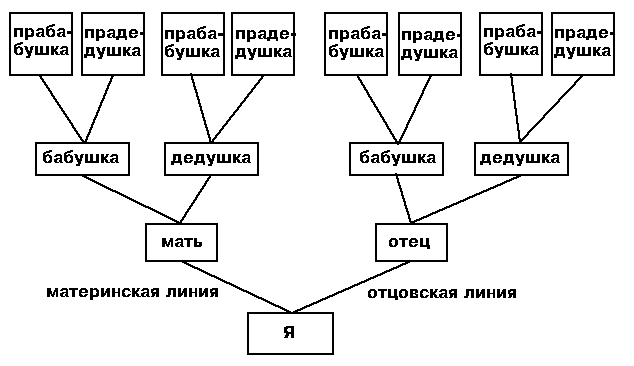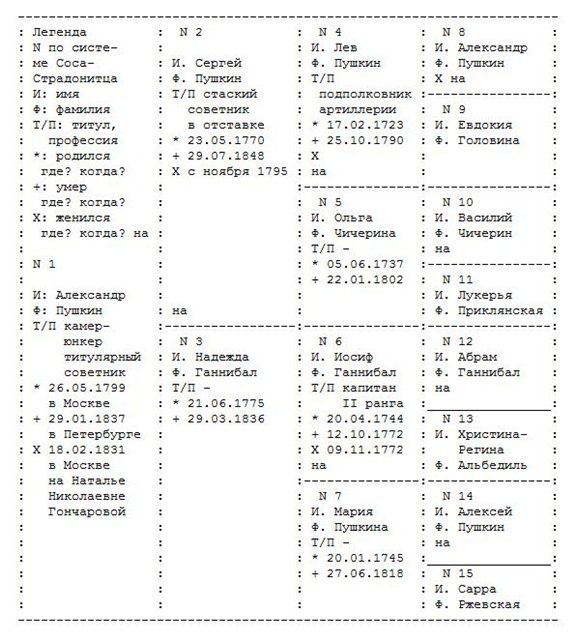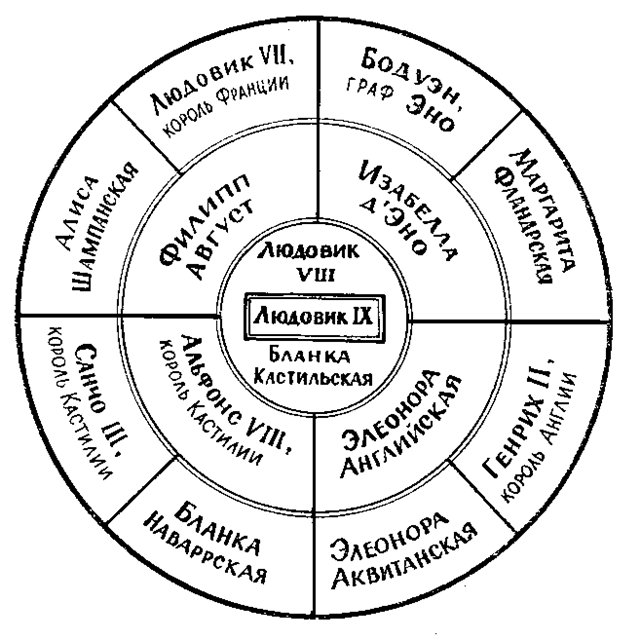Pedigree Compilation Guide - 3
Chapter II. THEORY
1. Types of genealogies.
a) In genealogy, two are possible research directions:
- ascending,
- downward.
In ascending lineage, the object of research is the person whose ancestors are being collected. They begin with it, then go up the ascending steps or knees, i.e. to father, grandfather, great-grandfather, etc. This is the initial type of genealogy, when the researcher still has little information, when he consistently goes from the known to the unknown.
Descending ancestry begins with the most distant ancestor known and gradually moves on to its descendants. Such a genealogy allows you to visually represent the general picture of the life and activities of the clan, starting from more distant times and gradually expanding to the present day.
Both ascending and descending lineages are male and mixed.
Male descending A genealogy is a genealogy that indicates all the offspring of a given ancestor, but that originated only from men, with respect to female representatives of the genus, it is limited to indicating the name of their spouses.
Mixed downstream such a genealogy is called, which points decisively to all the offspring of a given ancestor, both from men and from women. Such a genealogy is, of course, not the genealogy of one surname, since often covers a huge number of childbirths originating from one ancestor along the female lines. It is sometimes necessary to clarify family ties between lateral and very distant relatives and most often appears in inheritance proceedings.
Male ascendant the pedigree, when depicted, will look like a line, since in each generation there will be one ancestor of this person. This genealogy is used to prove the kinship of a person with some well-known historical figure distant in time.
Mixed ascending A pedigree is a genealogy that indicates all the ancestors of a given person, both in the male and female lines. Such a pedigree always has the correct form when depicted graphically, because in the first tribe one person is indicated, in the second - two, in the third - four, in the fourth - eight, etc. exponentially, and each of these persons in one tribe belongs to a different genus, so that in the fourth tribe we have representatives of eight different surnames, and in the fifth already sixteen, etc.
b) Family tree.
Figure # 1

Figure # 2
The pedigree can be arranged in the form of a tree, where the trunk is designated, for example, you, the branching of the trunk - your parents, smaller branches - grandparents, etc. Such a tree will be ascending (fig. №1). The descending tree looks like it, but your ancestor will be at the base, and you will be in the crown.
There are cases, but in the Russian genealogical practice of the 17th century it was considered a rule when the descending table turns over, as it were: the ancestor is placed in the top line, and then, on the corresponding horizontals, the generations of his descendants go down (Fig. 2). This is how genealogical tables are designed in Russian genealogical books of the 17th century and in Russian pre-revolutionary historical literature.
When decorating a tree, the name and surname are written on circles that are nailed on trunks and branches or are depicted as leaves or fruits suspended from a tree. All men with offspring are written on a yellow background, without children on a red background. The names of married women are in purple, the names of girls in blue. All living faces are on a green background, men are darker, women are lighter. This color is not a rule, but only a custom adopted in Western Europe, in Russia it is rarely used. Male names were written in rectangles or rhombuses, female names in circles or ovals. The reverse designation rarely happened.
The family tree looks nice and clear, but it cannot provide detailed information about the individuals mentioned in it.
c) Pedigree table.

Figure №3
The pedigree chart can tell you more about each character mentioned in it. Tables can also be ascending or descending. In general, the table is the same tree, only made not by drawing, but strictly graphically (Fig. No. 3). If the table is made graphically correctly - each generation is located strictly on the same horizontal - then the structure and family ties within the genus are clearly and visually reflected. Unlike an ascending table, it is very difficult to draw a descending table without errors: it contains not only a different number of names in each generation, but also a different number of descendants for each person in one generation.
d) Horizontal table.
A horizontal table presents the same data in a slightly different way. Since it is difficult to calculate the location of the faces in the table, on a modern printed sheet, it seems to "lie on its side". On the left is the person whose pedigree is being compiled, or the ancestor, and then - in columns, by generations, all his ancestors or descendants (Fig. No. 4). Unlike a top-down table, which is built vertically, where the seniority of persons in each generation goes from left to right, in a horizontal table the eldest son or daughter is always located at the top, and seniority is read from top to bottom.

Figure №4
The tables use widely recognized abbreviations and symbols:
AND.- name (patronymic is excluded in order to save space, in addition, it is restored by the name of the father)
F.- surname
T / P- title, profession (occupation, social status, specialty, titles, ranks, ranks, etc.)
* 1965 - born in 1965
+ 1991 - died in 1991
X 1990- married 1990
1) 1987 2) 1989- married several times in 1987 and in 1989
In addition to these signs, others are used:
* 1965 - born in 1965
)(1988 - divorced in 1988
(+) 1992 - buried in 1992.
Other designations may also be used.
Along with signs, abbreviations of the corresponding words are also used: father - O.; mother - m... If the exact date of birth, death or marriage is unknown, write "about" - OK., before, after... For example: * before 1914; X approx. 1940; + after 1970
Each name in the table is assigned its own number (for more details, see the section "Genealogical records").
e) Circular table.

Picture No. 5
A pie chart is another way to provide genealogical information. Such charts were widely used in English and French genealogy. In the center is the face, then the circle is divided in half, in one half are the ancestors on the paternal line, in the other - on the maternal side. Since the diagram can only double the number of people depicted from generation to generation, it becomes clear that circular tables are only ascending.
f) Genealogical listings.
List is a verbal retelling of the table. It makes it possible to put all the necessary information with each name. For the sample, the pedigree list of A.S. Pushkin's ancestors is given.
Pedigree list of A.S. Pushkin's ancestors.
1. Alexander Sergeevich Pushkin, b. 05/26/1799 in Moscow, died 01/29/1837 in St. Petersburg from a fatal wound received on 01/27/1837 in a duel with the cavalry guard J. Dantes. Buried in the cemetery of the Svyatogorsk monastery, Pskov province. In 1811-1817 - at the Tsarskoye Selo Alexandrovsky Lyceum, 06/13/1817 - was released from it with the rank of collegiate secretary and assigned to the department of the collegium of foreign affairs. From May 1820 - in the service in the Crimea, Chisinau and Odessa. 07/08/1824 - dismissed from service without being awarded a rank and sent to live under supervision in the village of Mikhailovskoye, Opochetsk district, Pskov province. In September 1826, he was released from exile and settled in Moscow. 11/14/1831 - appointed to the State Collegium of Foreign Affairs in the previous rank, and on 12/06/1831 - granted to titular advisers, 12/31/1833 - to the rank of chamber junker. 02/26/1836 - sent to the Moscow Main Archive for official duties.
J. from 18.02.1831 (in Moscow): Natalya Nikolaevna Goncharova, b. 27.08.1812, d. 11/26/1863, buried at the Lazarevskoye cemetery of the Alexander Nevsky Lavra in St. Petersburg. Daughter of Nikolai Afanasyevich Goncharov (10/20/1787 - 09/09/1861), the owner of the Linen Factory, and Natalia Ivanovna, nee Zagryazhskaya (10/22/1785 - 08/02/1848).
In his second marriage on 16.07.1844 to Adjutant General Pyotr Petrovich Lansky (1799-1877).
Children from the first marriage: Alexander (07/06/1833 - 07/19/1914), Grigory (05/14/1835 - 08/05/1905), Maria (05/19/1832 - 02/22/1919), Natalia (05/23/1836 - 03/10/1913).
1st generation
2. Sergei Lvovich Pushkin, b. 05/23/1770, d. 07/29/1848 and was buried in the Svyatogorsk monastery. In 1777 - sergeant of the Izmailovsky Life Guards regiment, 1791 - ensign, 1797 - lieutenant captain of the Life Jaeger Battalion, 1798 - retired major, 1800 - in the Commissariat state, 1811 - military adviser, 1814 - head of the Commissariat commission of the reserve army in Warsaw , 1817 - retired state councilor.
J. From November 1795:
3. Nadezhda Osipovna Hannibal, b. 06/21/1775, d. 03/29/1836 and was buried in the Svatogorsk monastery. Her dowry is the village of Mikhailovskoye.
2nd generation
4. Lev Alexandrovich Pushkin, b. 17.02.1723, d. 10/25/1790 and buried in the old cathedral of the Donskoy monastery. In 1739 - corporal, 1741 - sergeant, 1747 - bayonet-cadet, 1749 - second lieutenant, 1754 - captain, 1759 - major, 09/23/1763 - dismissed with the rank of lieutenant colonel of artillery.
First marriage married to Maria Matveevna Voeikova, died in a home prison, from her - three sons.
J. (second marriage):
5. Olga Vasilievna Chicherina, b. 06/05/1737, d. 01.22.1802. Daughter of Vasily Ivanovich Chicherin (1700-1793), the Poltava commandant, and Lukeria Vasilievna, nee Priklonskaya.
They have two sons and two daughters.
6. Joseph (Osip) Abramovich Hannibal, b. 04/20/1744, d. 12.10.1806. Captain II rank, landowner s. Mikhailovsky, Pskov province.
J. from 09.11.1772:
7. Maria Alekseevna Pushkina, b. 01/20/1745, d. 06/27/1818. Daughter of Alexei Fedorovich Pushkin (1717 - 1777) and Sarah Yurievna Rzhevskaya.
They have one daughter - Nadezhda.
In the pedigree murals with a name on the left side, a number is put in order. The numbering was invented by the German historian of the 16th century Michel Eisinger, improved in 1676 by the Spaniard Jerome Sosa, and completed two hundred years later by Stefan Stradonitz. A number according to the Sosa-Stradonitz system is assigned to all direct ancestors, men get even numbers, and women get odd numbers (with the exception of the person whose genealogy is drawn up). This table can be continued indefinitely, and: the father's number is the double product of the son's (daughter's) number, and the mother's number is the father's number plus one. By the number, you can easily determine the correspondence of descendants and ancestors. So the son of number 10 will be placed at number 5, wife at number 11, parents at numbers 20 and 21, and so on. For a genealogy to be scientific, it must first of all be reliable. And for this it is necessary that for each information the source from which it was drawn is indicated, which makes it possible to always check it.
g) Cards.
The information of the pedigree list can be easily transferred to cards, work with which is much more convenient and efficient, since any information about a particular ancestor can be entered into the card. As a sample, the genealogical card of the association of amateur genealogists, created on the basis of the card of French researchers, is given.







